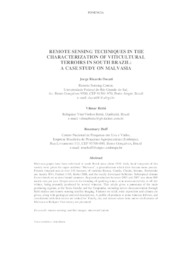Remote sensing techniques in the characterization of viticultural terroirs in South Braszil: a case study on Malvasia.
Remote sensing techniques in the characterization of viticultural terroirs in South Braszil: a case study on Malvasia.
Author(s): DUCATI, J. R.; BETTÚ, V.; HOFF, R.
Summary: Malvasia grapes have been cultivated in south Brazil since about 1930. Early local vineyards of this variety were given the vague attribute 'Malvasia', a generalization which later became more precise. Present vineyard area is over 110 hectares, of varieties Bianca, Candia, Chianti, Istriana. Rootstocks are mainly SO4, Paulsen 1103, Kober 5BB, and the locally developed Solferino. Subtropical climate favors bunch rot at more humid summers. Regional production between 2005 and 2007 was about 800 metric tons per year.
Publication year: 2009
Types of publication: Abstract in annals or event proceedings
Unit: Embrapa Grape & Wine
Keywords: Caracterização, Malvasia, Sensoriamento remoto, Terroir, Uva, Variedade, Viticultura
Observation
Some of Embrapa's publications are published as ePub files. To read them, use or download one of the following free software options to your computer or mobile device. Android: Google Play Books; IOS: iBooks; Windows and Linux: Calibre.
Access other publications
Access the Agricultural Research Database (BDPA) to consult Embrapa's full library collection and records.
Visit Embrapa Bookstore to purchase books and other publications sold by Embrapa.

